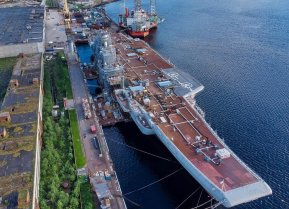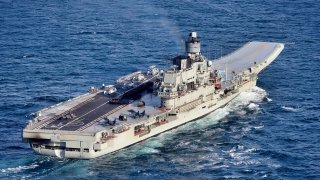Admiral Kuznetsov: Russia's 'Problem Child' Aircraft Carrier Is Also a Guided Missile 'Truck'
The Russian Navy's sole aircraft carrier, Admiral Kuznetsov, has faced numerous setbacks, reflecting broader challenges for Russia's military amid the Ukraine conflict and international sanctions.
The Nightmare: The Russian Navy's sole aircraft carrier, Admiral Kuznetsov, has faced numerous setbacks, reflecting broader challenges for Russia's military amid the Ukraine conflict and international sanctions.
What Is Occurring: Initially pulled for repairs in 2017, the carrier's modernization has been delayed, pushing its expected reentry to service to 2024 or later. The Admiral Kuznetsov, a mix of aircraft carrier and guided-missile cruiser, has a problematic history, including fires, fuel spills, and poor-quality engines requiring frequent assistance.
More Significant Issues: Its STOBAR design limits its capabilities compared to U.S. carriers, and ongoing issues like extreme corrosion raise doubts about its future operational effectiveness.
The Russian Navy has been having some tough days at work over the past two years. Although the war in Ukraine is predominately a land conflict, the Ukrainians have managed to sink or damage several Russian warships, submarines, and support vessels.
To make matters worse for Moscow, its sole aircraft carrier is out of commission for repairs. A very interesting warship, the Admiral Kuznetsov is expected to enter service sometime in 2024.
However, the problems of the Russian military in Ukraine and the heavy international sanctions might delay the reentrance of Russia’s sole carrier.
The Admiral Kuznetsov
According to the Russian Navy, the Admiral Kuznetsov is a mix of aircraft carrier and guided-missile cruiser. As an aircraft carrier, it can carry up to 24 fighter jets and 12 helicopters, while as a heavy cruiser, it packs 12 P-700 anti-ship cruise missiles and almost 200 3K95 “Kinzhal” surface-to-air missiles.
The Russian naval doctrine doesn’t require a robust battle group around an aircraft carrier like the U.S. doctrine does. As such, the Admiral Kuznetsov needs robust anti-ship and air defense systems to ensure it survives in a modern battlefield.
As a warship with mixed roles (carrier and heavy cruiser), the Admiral Kuznetsov is a Short Take-Off, Barrier Arrested Recovery (STOBAR) carrier, meaning that it relies on a ski-jump to launch its fighter jets. Essentially an upward curving ramp at the fore of the carrier, the ski-jump assists aircraft in taking off. But the carrier must maintain a speed of between 20 to 30 nautical knots (37 to 55 miles per hour) to create the wind conditions necessary to help the fighter jets take off.
Although cheaper than Catapult Assisted Take-Off Barrier Arrested Recovery (CATOBAR) aircraft carriers—this is the type of carrier in service with the U.S. Navy—STOBAR carriers have more limited capabilities and can’t project force like their bigger siblings.
A Problematic History
Back in 2017, the Russian Navy pulled the aging aircraft carrier into land for much-needed maintenance. The repairs and modernization program sought to extend the life of the Admiral Kuznetsov by 10 to 15 years. The Kremlin’s timeline sought a delivery date of 2024.
“The transfer of the Admiral Kuznetsov cruiser to the fleet after modernization and all subsequent state tests will take place no earlier than in 2024,” the Russian state media TASS reported last year.
However, seven years after it began its modernization upgrades, the warship is still under repair, and it looks like it will be for some time to come.
The warship has had a turbulent history. Back in 2009, the Admiral Kuznetsov caught fire while underway in a deployment in the Eastern Mediterranean. One sailor was killed, and the ship suffered some damage. Then, during the same deployment, the warship started losing fuel, spilling hundreds of tons of naval fuel into the sea.
A main issue with the Admiral Kuznetsov is its engines. They are of poor quality, causing the warship to often need help from other warships. Another issue is extreme corrosion below the water line, threatening the warship with sinking.
About the Author
Stavros Atlamazoglou is a seasoned defense journalist specializing in special operations and a Hellenic Army veteran (national service with the 575th Marine Battalion and Army HQ). He holds a BA from Johns Hopkins University and an MA from the Johns Hopkins School of Advanced International Studies (SAIS). His work has been featured in Business Insider, Sandboxx, and SOFREP. Email the author: [email protected].
Image Credit: Creative Commons.


